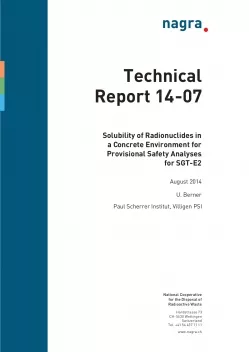
Technical Report NTB 14-07
Solubility of Radionuclides in a Concrete Environment for Provisional Safety Analyses for SGT-E2
Within stage 2 of the sectoral plan for deep geological repositories for radioactive waste in Switzerland provisional safety analyses are carried out. In the case of the repository for long-lived intermediate level waste (ILW) considered retention mechanisms include the concentration limits of safety relevant elements in the pore water of the engineered concrete system.
The present work describes the evaluation of solubility limits for the safety relevant elements Be, C, Cl, K, Ca, Co, Ni, Se, Sr, Zr, Nb, Mo, Tc, Pd, Ag, Sn, I, Cs, Sm, Eu, Ho, Pb, Po, Ra, Ac, Th, Pa, U, Np, Pu, Am and Cm in the pore water of a concrete system corresponding to a degradation stage characterised by portlandite (Ca(OH)2) saturation and by the absence of (Na,K)OH solutes.
The term solubility limit denotes the maximum amount of an element dissolving in the pore solution of the considered chemical reference system. Chemical equilibrium thermodynamics is the classical tool used for quantifying such considerations. For a given solid phase equilibrium thermodynamics predict the amount of substance dissolving in the solution and describe the speciation of the considered element in solution. The principles of chemical equilibrium will also be the primary work hypothesis in the present work.
Solubility calculations were performed with the most recent version of GEMS/PSI (GEMS3.2 v.890) using the PSI/Nagra Chemical Thermodynamic Data Base 12/07, which is an update of the former Nagra/PSI Chemical Thermodynamic Data Base 01/01. The database was complemented with datasets from the ThermoChimie v. 7b for elements that were not considered in the mentioned update (Ag, Co, Sm, Ho, Pa, Be), with data for hydrated cement phases from CEMDATA07, with data from IUPAC (Pb) and with data from the literature (Mo). Differing sources for thermodynamic data are noted.
Reference values solubilities as well as lower and upper guideline values are evaluated. For many formation constants of solids and solutes uncertainties are known and allow conveying lower and upper guideline values. In many cases it is not clear whether the most stable solid is formed. In such cases the (kinetically driven) formation of alternative solid phases is included in the derivation of reference and guideline values. This procedure is based on expert judgment. Corresponding justifications are given for the individual elements and are an important part of this work.
A similar report for an almost identical chemical environment has been produced in 2002, based on the PSI/Nagra Thermodynamic database 01/01. A comparison of the solubility limits with results from this former report and with regulatory recommendations to the values in this former report was made and is illustrated. With the criterion of a threshold value of ±0.5 log10-units (a factor of 3.2) the evaluated solubilities were classified within this comparison into lower, similar, and higher recommended values. With this classification 14 elements fall into the class of lower recommended solubilities (Be, Cinorg, Se, Zr, Mo, Tc, I, Sm, Ho, Po, Ra, Np, Pu, Am) and 15 elements (Cl, K, Ca, Co, Sr, Nb, Pd, Sn, Cs, Eu, Pb, Ac, Th, U, Cm) into the class of similar recommended solubilities. Only three elements (Ni with a factor of 10, u with a factor of 70, Pa with a factor of 200 and Ag with a factor "high") exhibit higher recommended solubilities than evaluated in the former report.
A specific request concerned the potential impact of isosccharinic acid (ISA) on the solubility of the elements. ISA is at elevated pH a stronly complexing product of cellulose degradation. The isosaccharininate anion (ISA-) is known to form strong complexes with di-, tri- and tetravalent cations and therefore to stabilise increased concentrations in solution. Thermodynamic complex formation data for relevant elements were collected from a recent NEA review (Hummel et al. 2005). Solubility calculations were repeated for these elements in the presence of 5 × 10-3 [mol/kg H2O] of ISA- and a solubility enhancement factor was established. Low solubility enhancement factors were found for Ca (1.1), Ni (1.2), Pa (1.3), U (1.2), Np (3.5) and Pu (3.5). Considerable enhancement factors were found for Zr (109), Sm (630), Eu (263), Ho (632), Po (731), Ac (263), Th (731), Am (165) and Cm (165), where the ISA--complexes strongly dominate the speciation in solution. Since rather high ISA- concentrations were selected to study their impact on solubility, it can be concluded that in the worst case dissolved ISA has a detrimental impact on solubilites of tri-valent elements as well as Po and Th.
